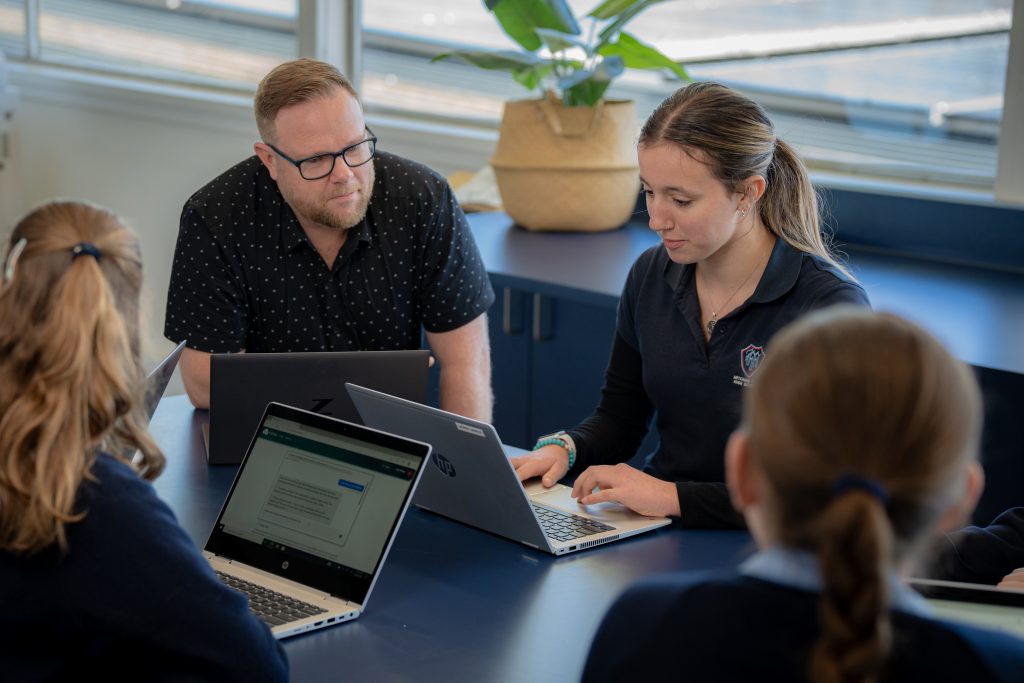
Learning in the AI era: How South Australia’s Department for Education is empowering students and teachers with AI in the classroom
Recent advances in Artificial Intelligence (AI), including the public release of generative AI services such as ChatGPT, have the potential to disrupt every industry, including Education. As a response to this, the South Australia Department for Education has harnessed the power of AI to build and trial a chatbot that has been designed specifically for teaching and learning. ‘EdChat’ is the first chatbot of its kind in Australia and one of the first in the world to be introduced in an educational setting.
According to Martin Westwell, Chief Executive of the SA Department for Education, EdChat was born as a response to tools like ChatGPT entering the market, providing teachers and students with a safe environment in which to explore AI and to develop the skills of the future.
“We realised that if this tool is out there and if it’s going to transform the future workforce, the only question to ask ourselves is ‘how do we learn to use this safely and ethically to positively impact teaching and learning?’” says Westwell. “EdChat is the first step in our strategy to maximise the value AI can deliver in the education space, while minimising the risk.”
EdChat is a crtitical part of the Department’s vision to tackle the generative AI disruption head-on, empowering students to go into the world with the skills and knowledge they need to thrive in the era of AI.
The chatbot was designed in partnership with Microsoft and uses the Azure OpenAI service, powered by the same technology as ChatGPT. Students can enter prompts to get information on a topic, ask for creative suggestions or analyse complex ideas through EdChat’s simple, intuitive interface designed by the Department’s IT partner, Insight Enterprises.
“EdChat is a truly inspiring example of how the education sector can embrace generative AI to deliver value to its most important stakeholders – students,” says Veli Mati-Vanamo, CTO (APAC) of Insight Enterprises.
“This breakthrough technology empowers students to take control of their own learning, improve their academic performance, and develop essential skills for their future careers.”
More than 1,500 students and 150 educators from eight schools in SA took part in an initial eight-week trial completed in August this year. School principals had full control over how many students and teachers used EdChat, and how they used it during the trial period.
Boosting creativity and critical thinking
In early trials, students asked EdChat for prompts or suggestions to tweak their ideas for schoolwork, stimulating their creativity and critical thinking. They also asked questions to better understand complex concepts or topics.
EdChat proved extremely helpful in allowing students to access vast amounts of information quickly, and have this information synthesised into simple, easy-to-understand language.
At the start of the trial, around 20 per cent of students were shown to be actively using EdChat, with that number surging towards the end of the eight-week period, as teachers and students gained familiarity with the tool and how it could support critical and creative thinking.
Rosie Heinicke is the principal at Mitcham Girls High School, one of the eight schools participating in the trial. She says that students found real value in using the tool to help their learning.
“As an all-girls school, it was really important to us that we get our students comfortable and familiar with what is going to be defining technology for their generation. Too many women are discouraged from STEM simply because they lack this confidence,” says Heinicke.
“We found that students responded really well to EdChat because it gives them a safe space to ask questions and explore ideas without any judgment. It also gives them agency to direct their own learning.”
Heinicke says some of the most noticeable benefits of EdChat for students was that they had 24/7 access to a safe source of instantaneous information. Rather than having to wait for a teacher to come around the room to give them guidance, students could get quick answers from EdChat before discussing more complex and nuanced questions with their teachers.
“We are also seeing how EdChat helps with ‘metacognition’, or the student’s understanding of how they learn,” says Heinicke.
It’s an extremely powerful shift to see our students go from learning to answer questions, to instead learning how to ask the right questions.
Introducing AI safely and ethically
A key element of the trial was testing the technology in an actual school setting by putting the chatbot into the hands of students and teachers, so the Department could gain a better understanding of the solution’s limits and abilities.
“Going into this project, the Department was very aware that we were navigating uncharted waters,” says Chief Information Officer at the Department, Daniel Hughes. “This kind of project had never been done before and we didn’t have all the answers, so we relied heavily on the Microsoft team to guide us through the process.”
The two biggest concerns going into the project were student data privacy and the appropriate use of AI. From a technical perspective, the Department was able to navigate those challenges by leveraging its existing investment in Microsoft technology, and its built-in mechanisms for data collection and secure storage.
As this service is hosted in the Department’s private tenancy, safety measures and controls have been built into the system, utilising the Azure AI Content Safety service. By detecting and blocking potentially harmful content flowing through the AI system, the Department can be confident that EdChat is safe and appropriate for students. Comprehensive logging of all interactions with EdChat also ensures that student data is kept secure while still allowing school staff visibility over student usage, even on the weekends and outside of school.
With students given free rein over how they used EdChat and what prompts they could enter, the trial was also a test of how effective EdChat’s guardrails and safety controls were.
“We now know that EdChat was safe and appropriate for school use,” says Hughes, “and that gives us confidence to readjust some of those controls and settings for different cohorts, as we roll it out more widely.”
It also allowed the Department and teachers to understand generative AI’s limitations and how these present learning opportunities for students. “Students were cross-checking EdChat’s answers and occasionally finding inaccuracies or improper sources,” says Heinicke. “And rather than that be a disappointment to them, they took it as a chance to learn how to ask more targeted questions and how to interrogate the answers provided to them.”
Empowering the next generation
The first trial was conducted at a small scale, with participating schools selected based on their level of digital maturity. According to Hughes, the next phase of the trial will see a controlled expansion, gradually rolling out to more schools so the Department can continue to maintain a high level of engagement and support for the participating schools.
“Teachers and students are asking that we don’t take EdChat away,” says Heinicke. “They say they’re just getting the hang of it and keep finding new ways to use it and get value from it, so it’s very promising to see the attitudes towards AI evolving so positively after just eight weeks.”
Upon completion of the trial, the Department has earned confidence in EdChat’s underlying architecture and the efficacy of the controls in place.
“Our next steps are to get EdChat out to the schools and students who stand to benefit the most from AI,” says Hughes. “Schools in remote or rural areas and those that serve communities in lower socioeconomic areas can explore differentiated learning, and other ways to use AI to drive equity in education.”
The project is a world-leading opportunity for stakeholders from the education sector and the technology industry to work together to empower the next generation to innovate with AI and transform Australia’s future.















